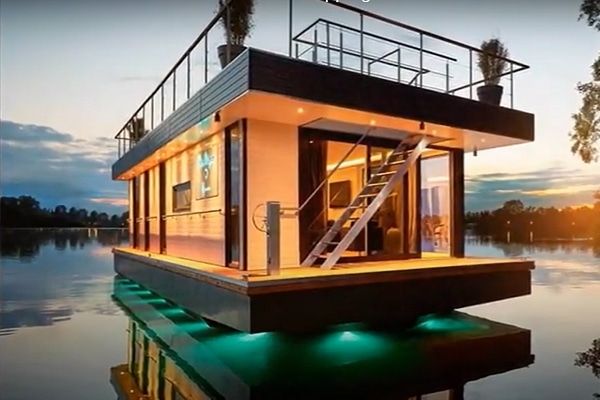- Rent, Lease, or Purchase
- |
February 3, 2020
Here’s How to Keep Moisture Out of Storage Containers


Keeping moisture out of storage containers is imperative to preserving the unit, as moisture accumulation leads to corrosion, structural damage, and mold.
If you’re interested in learning how to keep moisture out of storage containers, you should look into installing ventilation, using desiccants, and adding insulation. Of course, there are a few additional steps to consider.
Below, we’ve outlined different prevention methods that can help you reduce the moisture in your storage container.
What is Shipping Container Condensation?
Extreme temperature changes and humidity in a storage or shipping container can result in “cargo sweat,” or moisture droplets and condensation usually forming on the ceiling.
Once the walls cool down below the dew point, the air inside can no longer hold moisture. These droplets then fall onto goods - an occurrence often referred to as “container rain” - which can damage the goods in storage or transit.
Moisture prevention in shipping containers is a crucial design consideration. Remember, the metal body makes it susceptible to frequent temperature fluctuations.
The following factors can significantly influence the condensation levels in the container:
- Air space: As the open space in the unit increases, the amount of moisture-containing air entering increases.
- Ventilation: A lack of ventilation can obstruct airflow, leading to moisture accumulation. Adequate airflow also equalizes the temperature inside the container with the outside air, further reducing condensation.
- Stored goods: If you keep hygroscopic items such as paper, cardboard, wood, food, and beverages, the amount of moisture in your storage unit will increase. These goods release moisture when the outside temperature drops.
- Usage: The frequency of door opening, local climate, and wind conditions also increase condensation in shipping containers.
Effect of Humidity in a Shipping Container/Storage Unit

Shipping container condensation can compromise the container along with the goods stored inside. Mold, fungus, rust, odor, discoloration, and packaging breakdown can result in costly damages.
Some of the ways in which moisture affects shipping containers are:
- Rapid corrosion of the walls
- Mold and mildew
- Packaging deterioration
- Warping on materials like wood and plastic
- Caking of powder goods
It's important to take steps to prevent moisture build-up to avoid financial losses and increase the lifespan of the container.
How to Keep Shipping Containers Dry
Shipping containers are made of steel and can resist extreme cold temperatures. They're also tightly sealed and make for highly secure storage boxes. However, steel is not entirely waterproof, meaning it's susceptible to corrosion.
While it's virtually impossible to eliminate moisture build-up, these are some simple yet effective steps that can help protect your containers from condensation.
Select Suitable Pallets
Wooden pallets can help store goods safely, but they can absorb anywhere between 35-60% moisture from their surroundings. Freshly cut wooden pallets are even worse. It’s most effective to use plastic pallets. If you really need to use wood, make sure it's completely dry.
Use a Desiccant

Desiccants like silica gel are another way to help prevent condensation in shipping containers. They absorb moisture in the air and help keep the container dry. Besides silica gel, calcium sulfate, charcoal, and calcium chloride can all function as desiccants.
Another advantage of using desiccants is that they lower the dew point (the temperature at which water vapor turns to liquid condensate).
Efficient methods of using desiccants include:
- Install poles filled with a desiccant on the container walls
- Place desiccant-filled dry bags on the floor
- Apply special paints on the roof
If you're using a desiccant, make sure you’re using the right amount. Keep tabs on when the desiccant depletes and replace it periodically. Another essential consideration is product compatibility; if you're storing wet or high moisture products, a desiccant can lower the product weight.
Add Insulation

Insulated walls can also prevent moisture from getting into the container. However, if there's high humidity near your storage unit, you should look into other methods.
Install Ventilation

Installing container vents can help equalize temperature differences by introducing additional airflow. Ventilation removes warm moist air and draws the same temperature ambient air inside, stabilizing the humidity inside.
You can install grate-style vents and louver vents to prevent condensation. You can also use exhaust fans to reduce moisture.
Open the Doors to Air Out the Unit Periodically
Keeping the doors and windows open aso helps prevent moisture build-up. Of course, you'll need to make sure that your container is secure to avoid any unwarranted entry.
Install an Air-conditioner or Dehumidifier

It’s important to consider the following factors before selecting a dehumidifier:
- Your storage unit has easy access to a power source.
- You are emptying the water regularly or have an exhaust hose outside the container.
- A dehumidifier can cost upwards of $300, so it’s important to weigh the cost and benefits before selecting a system. If you're storing valuable goods or have your storage container in a location prone to severe condensation, the investment is likely worth it.
Our guide can help you understand shipping container heating and cooling in detail.
Bonus Tips
Quantification is the most effective method of preventing condensation. Moisture meters can help detect humidity levels inside of your storage unit. Once you know the amount of moisture present in the structure, you start working to eliminate condensation from the container.
Listed below are some recommended moisture meters you can use to decrease moisture in your shipping container:
General Tools 4-in-1 Digital Meter

Source: Amazon
You can use this moisture meter for walls, carpets, flooring, drywall, plywood flooring, soil, paper, and powders. The moisture level detects 5 to 50 percent moisture for wood and 1.5-33 percent for other building materials. You can also measure temperature in the 32-140 degrees range.
This 4-in-1 digital meter is a DIY device that uses flat, pinless sensors to detect moisture without damaging the material. Once the meter finds moisture, you can remove the cap to measure the humidity within five percent of accuracy and temperature within two degrees of accuracy.
Protimeter BLD5365 Surveymaster Moisture Meter

Source: Amazon
The Protimeter BLD5365 features two 5-inch pins that can penetrate inside a container. There's also a moisture probe that you can plug into the unit and take a reading in hard-to-access locations. You can use the calibration tool in the kit to ensure the readings are accurate.
The kit offers two modes of operations: search and measure. The pinless sensor detects moisture, while the pin sensors help measure the amount of moisture in concrete, wood, vinyl, drywall, and tiles. It has a relative scale of 70 to 999 that works as follows:
- 70-169 - Dry
- 170-199- At Risk
- 200-999- Wet
Conclusion
Humidity and condensation can pose a serious risk to the structural integrity of the container and its stored products. Taking adequate measures can help reduce the moisture content and eliminate condensation hazards. Estimating the humidity makes it possible to devise effective measures for keeping moisture out of storage containers.
Mobile Modular Portable is the leading supplier of new and used containers for rent and sale. We also provide shipping container storage units and offices equipped with insulation and HVAC units for adequate ventilation.
Call us today at 866-691-6474 or contact us today to learn more about how our shipping container solutions apply to your industry.
Frequently Asked Questions
Are Shipping Containers Waterproof?
Shipping containers have wind and watertight bodies that help transport cargo over large distances. However, their steel body remains vulnerable to temperature differences. If the outside temperature reduces drastically, the moisture-filled air inside the container can condense and accumulate water droplets on the walls.
What Causes Moisture in Shipping Containers?
Shipping containers have metal walls that readily absorb and reject heat. Any temperature change outside the container will lead to quick heat transfer. Once the temperature drops beyond the dew point, the moisture in the air will condense and lead to accumulation. This is one of the leading causes of moisture in shipping containers.
How Can I Prevent Mold in a Storage Container?
Moisture accumulation can lead to mold growth in the shipping container storage units. You can reduce the extent of condensation by using an appropriate desiccant, improving the ventilation, or installing dehumidifiers inside the unit. Frequently opening the doors and airing the container can prevent moisture build-up and subsequent mold growth.
Related Blogs



Subscribe to Our Blog
Enter your email address to subscribe to the blog and receive the notification of new posts by email.
Thank You for Subscribing to Our Blog!
Stay tuned for upcoming emails with valuable content that we hope will enhance your experience with our brand.
Both Pardot and mg360 form submissions failed.
